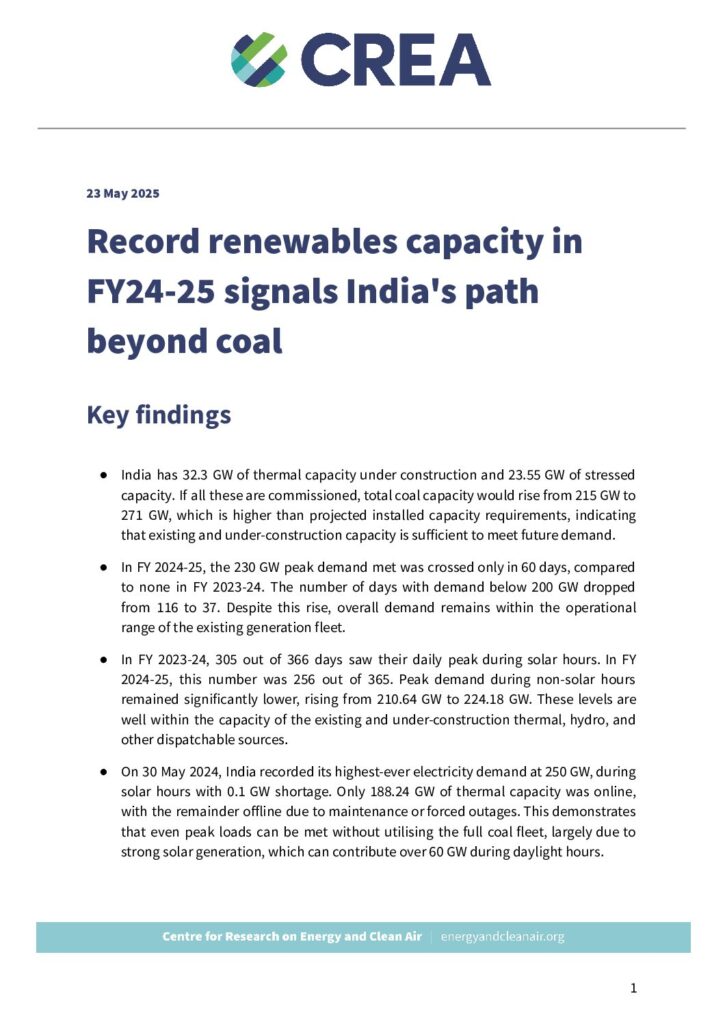India’s power sector stands at a critical juncture, marked by record-high installed capacity and a rapidly evolving energy mix. With a total installed power capacity of over 475 GW, the country continues to rely heavily on coal, yet the momentum behind renewable energy has never been stronger. Recent years have seen unprecedented growth in solar and wind installations, alongside steady contributions from large hydro and other sources. At the same time, the sector faces important questions about the future role of coal, the pace of capacity additions, and the reliability of supply as electricity demand continues to rise.
India has 32.3 GW of thermal capacity under construction and 23.55 GW of stressed capacity. This new report from the Centre for Research on Energy and Clean Air (CREA) finds that if all these plants are commissioned, total coal capacity would rise from 215 GW to 271 GW, which is higher than projected installed capacity requirements, indicating that existing and under-construction capacity is sufficient to meet future demand.
In FY 2024-25, the 230 GW peak demand met was crossed only on 60 days, compared to none in FY 2023-24. The number of days with demand below 200 GW dropped from 116 to 37. Despite this rise, overall demand remains within the operational range of the existing generation fleet.
In FY 2023-24, 305 out of 366 days saw their daily peak during solar hours. In FY 2024-25, this number was 256 out of 365. Peak demand during non-solar hours remained significantly lower, rising from 210.64 GW to 224.18 GW. These levels are well within the capacity of the existing and under-construction thermal, hydro, and other dispatchable sources.
On 30 May 2024, India recorded its highest-ever electricity demand at 250 GW, during solar hours with 0.1 GW shortage. Only 188.24 GW of thermal capacity was online, with the remainder offline due to maintenance or forced outages. This demonstrates that even peak loads can be met without utilising the full coal fleet, largely due to strong solar generation, which can contribute over 60 GW during daylight hours.
India currently has 234 GW of renewable energy capacity in the pipeline, which will further reduce pressure on thermal resources as solar continues to dominate during peak hours.

A recent study shows that India can meet its projected electricity demand by 2030 without adding any new coal capacity, if it achieves a 600 GW non-fossil target (377 GW solar, 148 GW wind, 62 GW hydro, 20 GW nuclear). Even under faster-than-expected demand growth, this high-renewables pathway remains the most cost-effective. It would reduce power procurement costs while eliminating the need for new coal plants.
However, realizing this scenario hinges on complementary investments: energy storage, transmission upgrades, and enhanced grid coordination. Another study finds that if battery storage costs decline by 15% annually, India can cap coal capacity at 260 GW by 2030, as planned in the National Electricity Plan, avoiding new coal entirely. Even with slower (7%) storage cost declines, coal use would plateau, and only limited additional capacity may be needed to manage non-solar peaks. Renewables, even with integration and balancing costs, have already become cheaper than coal-based generation, reducing reliance on costly thermal plants.
Rather than adding more coal plants and risking stranded assets, India’s energy future is better secured by accelerating renewables, upgrading the grid, expanding storage, and enhancing flexibility in the existing thermal fleet.
